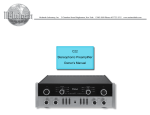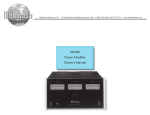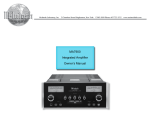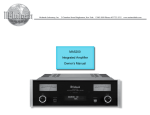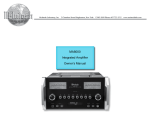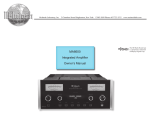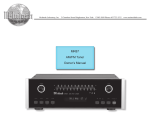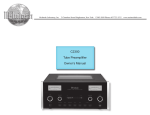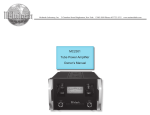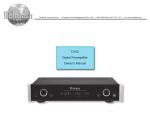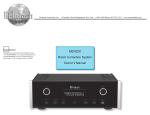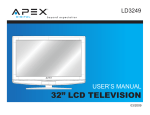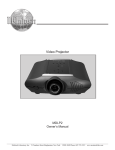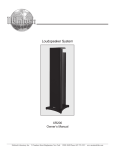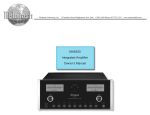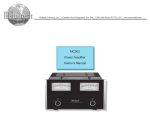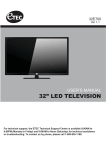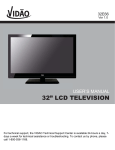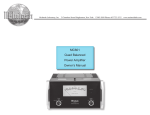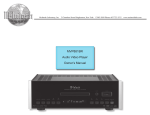Download McIntosh C48 audio amplifier
Transcript
McIntosh Laboratory, Inc. 2 Chambers Street Binghamton, New York C48 Audio Preamplifier Owner’s Manual 13903-2699 Phone: 607-723-3512 www.mcintoshlabs.com The lightning flash with arrowhead, within an equilateral triangle, is intended to alert the user to the presence of uninsulated “dangerous voltage” within the product’s enclosure that may be of sufficient magnitude to constitute a risk of electric shock to persons. WARNING - TO REDUCE RISK OF FIRE OR ELECTRICAL SHOCK, DO NOT EXPOSE THIS EQUIPMENT TO RAIN OR MOISTURE. IMPORTANT SAFETY INSTRUCTIONS! PLEASE READ THEM BEFORE OPERATING THIS EQUIPMENT. 1. Read these instructions. 2. Keep these instructions. 3. Heed all warnings. 4. Follow all instructions. 5. Do not use this apparatus near water. 6. Clean only with a dry cloth. 7. Do not block any ventilation openings. Install in accordance with the manufacturer’s instructions. 8. Do not install near any heat sources such as radiators, heat registers, stoves, or other apparatus (including amplifiers) that produce heat. 9. Do not defeat the safety purpose of the polarized or grounding-type plug. A polarized plug has two blades with one wider than the other. A grounding type plug has two blades and a 2 The exclamation point within an equilateral triangle is intended to alert the user to the presence of important operating and maintenance (servicing) instructions in the literature accompanying the appliance. NO USER-SERVICEABLE PARTS INSIDE. REFER SERVICING TO QUALIFIED PERSONNEL. third grounding prong. The wide blade or the third prong are provided for your safety. If the provided plug does not fit into your outlet, consult an electrician for replacement of the obsolete outlet. 10. Protect the power cord from being walked on or pinched particularly at plugs, convenience receptacles, and the point where they exit from the apparatus. 11. Only use attachments/accessories specified by the manufacturer. 12. Use only with the cart, stand, tripod, bracket, or table specified by the manufacturer, or sold with the apparatus. When a cart is used, use caution when moving the cart/ apparatus combination to avoid injury from tip-over. 13. Unplug this apparatus during lightning storms or when unused for long periods of time. 14. Refer all servicing to qualified service personnel. Servicing is required when the apparatus has been damaged in any way, such as power- To prevent the risk of electric shock, do not remove cover or back. No user-serviceable parts inside. supply cord or plug is damaged, liquid has been spilled or objects have fallen into the apparatus, the apparatus has been exposed to rain or moisture, does not operate normally, or has been dropped. 15. Do not expose this equipment to dripping or splashing and ensure that no objects filled with liquids, such as vases, are placed on the equipment. 16. To completely disconnect this equipment from the a.c. mains, disconnect the power supply cord plug from the a.c. receptacle. 17. The mains plug of the power supply cord shall remain readily operable. 18. Do not expose batteries to excessive heat such as sunshine, fire or the like. 19. Connect mains power supply cord only to a mains socket outlet with a protective earthing connection. Thank You Customer Service Your decision to own this McIntosh C48 Audio Preamplifier ranks you at the very top among discriminating music listeners. You now have “The Best.” The McIntosh dedication to “Quality,” is assurance that you will receive many years of musical enjoyment from this unit. Please take a short time to read the information in this manual. We want you to be as familiar as possible with all the features and functions of your new McIntosh. If it is determined that your McIntosh product is in need of repair, you can return it to your Dealer. You can also return it to the McIntosh Laboratory Service Department. For assistance on factory repair return procedure, contact the McIntosh Service Department at: Please Take A Moment The serial number, purchase date and McIntosh Dealer name are important to you for possible insurance claim or future service. The spaces below have been provided for you to record that information: Serial Number:________________________________ Purchase Date:_ _______________________________ Dealer Name:_ ________________________________ Technical Assistance If at any time you have questions about your McIntosh product, contact your McIntosh Dealer who is familiar with your McIntosh equipment and any other brands that may be part of your system. If you or your Dealer wish additional help concerning a suspected problem, you can receive technical assistance for all McIntosh products at: McIntosh Laboratory, Inc. 2 Chambers Street Binghamton, New York 13903 Phone: 607-723-3512 Fax: 607-724-0549 McIntosh Laboratory, Inc. 2 Chambers Street Binghamton, New York 13903 Phone: 607-723-3515 Fax: 607-723-1917 Table of Contents Safety Instructions...................................................... 2 Thank You and Please Take a Moment....................... 3 Technical Assistance and Customer Service.............. 3 Table of Contents........................................................ 3 General Information................................................... 4 Connector and Cable Information.............................. 4 Introduction................................................................. 5 Performance Features................................................. 5 Dimensions................................................................. 6 Installation.................................................................. 7 Connections: Rear Panel Connections............................................... 8 (Separate Sheet)................................................... Mc2B Connecting Components.............................................. 9 Connection Diagrams (Separate Sheets)................... Mc1A, Mc1B and Mc2A Front Panel: Front Panel Displays, Controls, Push-buttons and Jack...................................................................... 12 Setup: How to Operate the Setup Mode............................... 13 Default Settings......................................................... 13 Firmware Version....................................................... 13 Source Inputs Reassignment...................................... 13 Input Level Adjustment............................................. 14 Display Brightness..................................................... 15 Passthru...................................................................... 15 Power Control Triggers 1 and 2................................. 16 Comm Port Baud Rate............................................... 17 Remote Control Codes............................................... 17 Operation: How to Operate the C48............................................ 18 Trim Functions...................................................... 18-20 Equalizer Bypass....................................................... 21 Equalizer Controls..................................................... 22 Passthru...................................................................... 22 Optical and Digital Inputs.......................................... 23 USB Input Operation with a Computer..................... 23 Additional Information: Photos.................................................................... 24-25 Specifications............................................................. 26 Packing Instruction.................................................... 27 Remote Control: Remote Control Push-buttons.................................... 10 How to use the Remote Control..................................11 Copyright 2010 © by McIntosh Laboratory, Inc. 3 General Information and Connector Information General Information 1. For additional connection information, refer to the owner’s manual(s) for any component(s) connected to the C48 Audio Preamplifier. 2. The Main AC Power going to the C48 and any other McIntosh Component(s) should not be applied until all the system components are connected together. Failure to do so could result in malfunctioning of some or all of the system’s normal operations. When the C48 and other McIntosh Components are in their Standby Power Off Mode, the Microprocessor’s Circuitry inside each component is active and communication is occurring between them. 3. Balanced and Unbalanced Inputs and Outputs can be mixed. For example, you may connect signal sources to Unbalanced Inputs and send signals from the Balanced Outputs. You can also use Balanced and Unbalanced Outputs simultaneously, connected to different Power Amplifiers. 4. The C48 internal Digital to Analog Converter Circuitry is designed to decode 2-channel PCM (Pulse Code Modulation) Digital Signal present at the Coaxial and Optical Digital Audio Inputs. Other Digital Audio Signal Format Types will cause the Audio Outputs of the C48 to be muted and the Front Panel Information Display will indicate an error message. 5. The Remote Control Supplied with the C48 Integrated Amplifier is capable of operating other components. For additional information go to www. mcintoshlabs.com. 6. When discarding the unit, comply with local rules or regulations. Batteries should never be thrown away or incinerated but disposed of in accordance with the local regulations concerning battery disposal. 4 7. For additional information on the C48 and other McIntosh Products please visit the McIntosh Web Site at www.mcintoshlabs.com. Connector and Cable Information XLR Connectors Below is the Pin configuration for the XLR Balanced Input and Output Connectors on the C48. Refer to the diagrams for connections: PIN 1: Shield/Ground PIN 2: + Output PIN 3: - Output PIN 2 PIN 1 PIN 3 PIN 1 PIN 3 PIN 2 Power Control and Trigger Connectors The C48 Power Control Out, Trigger and Pass-Thru Output 1&2, Trig 1&2 Output Jacks send Power On/ and Pass-Thru Off Signals (+12 volt/0 volt) when connected to other Power McIntosh Components. An Control Meter additional connection is for Illumination controlling the illumination of Control Ground the Power Output Meters on McIntosh Power Amplifiers. A 1/8 inch stereo mini phone plug is used for connection to the Power Control, Trigger and Pass-Thru Outputs on the C48. Note: The Power Control, Trigger, Pass-Thru and Data Connecting Cable is available from the McIntosh Parts Department: Power Control, Trigger, Pass-Thru and Data Cable Part No. 170-202 Six foot, shielded 2 conductor, with 1/8 inch stereo mini phone plugs on each end. Data Port Connectors The C48 Data Out Ports send Remote Control Signals to Source Components. A 1/8 Data inch stereo mini phone plug is Signal used for connection. N/C Data Ground Introduction and Performance Features Introduction The McIntosh C48 Audio Preamplifier is one of the finest Preamplifiers ever created. The versatile Preamplifier provides connections for various input sources both analog and digital. The C48 Outputs have the ability to drive multiple Power Amplifiers. The C48 reproduction is sonically transparent and absolutely accurate. The McIntosh Sound is “The Sound of the Music Itself.” Performance Features • Electromagentic Input Switching with Level Trim Adjustment Digital Logic integrated circuits drive Electromagnetic Switches on all Inputs and operating functions for reliable, noiseless, distortion free switching. All eight Inputs on the C48 can be matched in level, so there are no abrupt changes in volume levels between the different Inputs. • Moving Coil and Moving Magnet Phono Inputs The C48 contains two different precision Phono Preamplifier Circuits. One for low output Moving Coil Phono Cartridges with selectable resistance loading, the other is for Moving Magnet Cartridges with selectable capacitive loading. Both circuits use the latest designs to provide the lowest possible noise and distortion. The RIAA Correction Equalization Circuitry utilizes close tolerance resistors and capacitors for an extremely flat frequency response. • Digital Audio Inputs The C48 has Coaxial, Optical and USB Digital Inputs to Decode PCM Signals from an external source. The C48 Up Samples the Digital Signal to 192kHz with 32Bit resolution before the Digital to Analog process begins. The USB Input sends basic commands (e.g. Play/Pause, Next, Back, etc.) to the computer by using the C48 Remote Control. • Balanced Inputs The Balanced Inputs allow the connection of a source component using long cable lengths without a loss in sound quality. • Precision Tracking Volume Control Volume levels are controlled by a new Multi-Stage Precision Digitally Controlled Attenuator System with a tracking accuracy of 0.1dB. • Variable Rate Volume and Balance Controls The C48 Preamplifier’s Volume and Balance Control Circuitry provides an ideal rate of change with control rotation. • Equalizer Controls with Bypass The Equalizer Circuitry provides 12dB of boost or cut at five different center frequencies. When an Equalizer Control is in the center position, all Circuit Components are removed from the Signal Path. The C48 remembers the Equalizer Circuitry Bypass Option for each input. • Pass-Thru Mode The Automatic Pass-Thru Mode allows the C48 to become part of a Multichannel Sound System for DVDAudio, SACD and Home Theater Movies. • Alphanumeric Fluorescent Display The Front Panel Information Display indicates the Source Selection, Volume/Balance Levels and Setup Mode Selections. The display intensity is adjustable. • Remote Control with External Sensor Input The Remote Control provides control of the C48 operating functions and McIntosh Source Components connected to it. Enjoy your McIntosh System from another room in your home by connecting an external sensor. • Power Control Output and Trigger Assignment A Power Control connection for convenient Turn-On of McIntosh Power Amplifiers, Source Components and Accessories is included. The Power Control Trigger Ouputs may be assigned to activate when a given Input is selected. • Special Power Supply Fully regulated Power Supplies and a special R-Core Power Transformer ensure stable noise free operation even though the power line varies. • Fiber Optic Solid State Front Panel Illumination The even Illumination of the Front Panel is accomplished by the combination of custom designed Fiber Optic Light Diffusers and extra long life Light Emitting Diodes (LEDs). • Glass Front Panel and Super Mirror Chassis Finish The famous McIntosh Illuminated Glass Front Panel and the Stainless Steel Chassis with Super Mirror Finish ensures the pristine beauty of the C48 will be retained for many years. 5 Dimensions Dimensions The following dimensions can assist in determining the best location for your C48. There is additional information on the next page pertaining to installing the C48 into cabinets. Front View of the C48 17-1/2" 44.45cm 5-3/8" 13.69cm 6" 15.24cm Side View of the C48 16-1/2" 41.91cm 14-1/2" 36.83cm 3/16" 4-13/16" 0.48cm 12.22cm Rear View of the C48 17-1/8" 43.50cm 4-5/8" 11.75cm 13/16" 2.06cm 10-9/16" 26.83cm 1-15/16" 4.92cm 13 -1/4" 33.66cm 6 2" 5.08cm Installation Installation The C48 can be placed upright on a table or shelf, standing on its four feet. It also can be custom installed in a piece of furniture or cabinet of your choice. The four feet may be removed from the bottom of the C48 when it is custom installed as outlined below. The four feet together with the mounting screws should be retained for possible future use if the C48 is removed from the custom installation and used free standing. The required panel cutout, ventilation cutout and unit dimensions are shown. Always provide adequate ventilation for your C48. Cool operation ensures the longest possible operating life for any electronic instrument. Do not install the C48 directly above a heat generating component such as a high powered amplifier. If all the components are installed in a single cabinet, a quiet running ventilation fan can be a definite asset in maintaining all the system components at the coolest possible operating temperature. A custom cabinet installation should provide the following minimum spacing dimensions for cool operation. Allow at least 2 inches (5.08cm) above the top, 2 inches (5.08cm) below the bottom and 1 inch (2.54cm) on each side of the Preamplifier, so that airflow is not obstructed. Allow 20 inches (50.8cm) depth behind the front panel. Allow 1-7/16 inch (3.66cm) in front of the mounting panel for knob clearance. Be sure to cut out a ventilation hole in the mounting shelf according to the dimensions in the drawing. 17-3/16" 43.66cm C48 Front Panel Custom Cabinet Cutout 4-7/8" 12.38cm Cabinet Front Panel Cutout Opening for Custom Mounting Cabinet Front Panel C48 Side View in Custom Cabinet Cutout Opening for Ventilation Support Shelf 2-1/4" 5.72cm Chassis Spacers 9-1/8" 23.18cm C48 Bottom View in Custom Cabinet 15" Cutout 38.10cm Opening for Ventilation 1-1/16" Note: Center the cutout Horizontally 2.70cm on the unit. For purposes of clarity, the above illustration is not drawn to scale. 15" 38.10cm 12-5/16" 31.27cm 7 Rear Panel Connections Rear Panel Connections The identification of Rear Panel Connections for the C48 Audio Preamplifier is located on a separate folded sheet contained in the Owner’s Manual Packet. Refer to separate sheet “Mc2B” for the Rear Panel Connections. C48 Audio Preamplifer Rear Panel 8 Connecting Components Connecting Components The C48 has the ability to automatically switch power On/Off to Source Components via the Power Control connections. The Data Port Connections allow for the remote operation of basic functions using the C48 Remote Control. With an external sensor connected to the C48, remote control operation of the system is possible from another room and/or when the C48 is located in a cabinet with the doors closed. The connection instructions below, together with the C48 Input/Output/Control Connection Diagrams located on the separate folded sheets “Mc1A/1B and Mc2A”, are an example of a typical audio system. Your system may vary from this, however the actual components would be connected in a similar manner. For additional information refer to “Connector and Cable Information” on page 4. Note: Source components may be connected to the C48 Balanced Inputs or Digital Inputs instead of Unbalanced Inputs. Refer to Setup “Reassigning Inputs” to activate them on page 13. Power Control Connections: 1. Connect a Control Cable from the C48 POWER CONTROL MAIN Jack to the Power Control In on the Turntable. 2. Connect a Control Cable from the Turntable Power Control Out Jack to the SACD/CD Player Power Control In Jack. 3. Connect a Control Cable from the SACD/CD Player Power Control Out Jack to the Tuner Power Control In Jack. 4. Connect a Control Cable from the Tuner Power Control Out Jack to the Music Server Power Control In Jack. 5. Connect a Control Cable from the C48 POWER CONTROL OUTPUT 1 Jack to the Power Amplifier Power Control In Jack. Note: If two Power Amplifiers are used, connect the Power Control Output of the first Amplifier to the Power Control Input on the second Amplifier. 6. Optionally connect a Control Cable from the C48 POWER CONTROL OUTPUT 2 Jack to the Power Amplifier (Secondary Room) Power Control In Jack. 7. Connect any additional Components in a similar manner, as outlined in steps 1 thru 4. Data Control Connections: 8. Connect a Control Cable from the C48 TUNER DATA PORTS Jack to the TUNER Data In Jack. 9. Connect a Control Cable from the C48 CD DATA PORT Jack to the SACD/CD Player Data In Jack. 10. Connect a Control Cable from the C48 SRVR DATA PORT Jack to the Music Server Data In Jack. 11. Connect any additional McIntosh Components in a similar manner, as outlined in steps 8 thru 10. Sensor Connection: 12. Connect a Control Cable from the C48 IR Input Connector to the external Sensor. Audio Connections: 13. Connect an Audio Cable from the C48 TUNER INPUT Jacks to the Tuner (Fixed) Output Jacks. 14. Connect an Audio Cable from the C48 CD INPUT Jacks to the SACD/CD Player (Fixed) Output Jacks. 15. Connect an Audio Cable from the C48 SRVR INPUT Jacks to the Music Server Output Jacks. 16. Connect an Audio Cable from the C48 RECORD OUTPUT Jacks to the Music Server Input 3 Jacks. 17. Connect the Audio Cables coming from the Turntable to the C48 MC PHONO INPUT Jacks. Note: If the Turntable has a Moving Magnet Cartridge connect the audio cables to the C48 MM PHONO INPUT instead of the MC Input. 18. Connect Balanced Cables from the C48 BALanced OUTPUT 1 connectors to the Power Amplifiers Balanced (Left and Right) Inputs. 19. Optionally Connect an Audio Cable from the C48 BALanced OUTPUT 2 connectors to the Power Amplifier (Secondary) Inputs. 20. Connect any additional McIntosh Components in a similar manner, as outlined in steps 14 thru 18. Optional “PassThru” Connections: 21. Connect Balanced Cables from the A/V Control Center Front Left and Right Channel Balanced Output connectors to the BALanced 2 Input connectors. Note: Refer to Setup “PassThru” on page 15 to activate the BALanced 2 Input. 22. Connect a Control Cable from the C48 PASSTHRU to A/V Control Center Zone ZA Power Control Output. Optional USB Connection: 23. Connect a USB cable with (type A to type B) connectors from the C48 USB D/A Input to an available USB connector. Ground Connections: 24. Connect the Ground Cable coming from the Turntable to the C48 GND Binding Post. AC Power Cords Connections: 25. Connect the C48 and any remaining components’ AC Power Cords to a live AC outlet as illustrated. 9 Remote Control Push-Buttons LED illuminates during the time a remote command is sent to the C48 Switches the Trigger 1 and/or 2 Power Control Jack(s) On/Off, refer to “Setup, Power Control TRIG 1 and TRIG 2” on page 15 for additional information Selects a Disc Player, Music Server or Recorder Function. Seek Stations Up or Down the AM/FM Dial. Select AM/FM Station Presets and performs various functions on a variety of McIntosh Components Displays On Screen Functions on the McIntosh Music Server and a variety of other McIntosh Components Adjusts the volume level up or down Mutes the audio Selects AM Tuner Operating Functions and Disc Selection on certain McIntosh Disc Players Functions as a “shift” key when used with the AM or FM pushbuttons to select Output 1 or 2 Scrolls through the available C48 Inputs Press to Power the C48 ON Press to Power the C48 OFF Press to change broadcast bands on an external McIntosh Tuner connected. Select certain functions on a variety of McIntosh Components Selects On Screen Functions on a variety of McIntosh Components Press TRIM and then the LEVEL Push-buttons to select and adjust various functions Selects FM Tuner Operating Functions and Track Selection on certain McIntosh CD Players Use to select tuner presets, disc tracks or any numbered operation Scrolls through the available C48 Inputs Selects one of the eight available Audio Sources Note: Push-buttons whose function is not identified above are for use with other McIntosh Products. 10 How to use the Remote Control How to use the Remote Control The supplied HR072 Remote Control is capable of directly controlling the functions of contemporary Source Components connected to the C48 via the Data Ports. Tuner Push-buttons Press the AM or FM Push-button to select the desired broadcast band. Press and release the Channel Up p or Down q Push-button to seek the next available station. Press and hold a Channel Up p or Down q Push-button to seek continuously from station to station. Input Source Selection Press the appropriate Source Push-button to select the desired program source. Volume Press the Up p or Down q VOLUME Push-button to raise or lower the listening volume level. Note: If at any time the C48 seems unresponsive to HR072 Remote Control Commands press the Push-button first. Note: When the C50 is Off, pressing one of the Source Push-buttons will switch the C50 On and will go to that Input. Mute Press the MUTE Push-button to mute the audio in all outputs except the REC OUTPUT. The word MUTE will appear on the Front Panel Information Display. To un-mute the audio, press the MUTE Push-button again. Disc, Server and Tape Functions Use these push-buttons to operate a DVD Player, CD Player, CD Changer, Music Server or Recorder. Numbered Push-buttons Press Push-buttons 0 through 9 to access tuner station presets, tracks on discs or selections on a Music Server. Disc and Track Use the AM (disc) and FM (track) Push-buttons when a Disc Player or Music Server is being used. Note: The Record Signals present at REC OUTPUTS are not affected by volume changes. Pause Press the Pause Push-button to perform various functions on a variety of McIntosh Components. It will also pause the playing of a disc or tape player. Trim Press the TRIM Push-button until the desired Trim function (Balance, Trim Level, etc.) appears on the Front Panel Information display, then press the LEVEL Up p or Down q Push-button to adjust the Trim setting. Note: Press the TRIM Push-button to recall the last Trim function selected. For additional information on the Trim Functions refer to pages 18, 19 and 20. Amplifier Selection Press the BLUE (Setup) Push-button followed by the AM (Output 1) or FM (Output 2) Push-button, to control the rear panel Audio OUTPUTS 1, 2 (ON or OFF) and Power Control OUTPUT 1 / OUTPUT 2. These OUTPUTS provide signals to a Power Amplifier or other accessory component. 11 Front Panel Displays, Controls, Push-buttons and Jack IR Sensor receives commands from a Remote Control EQUALIZER Controls increase or decrease the volume levels at the Center Frequencies of 30Hz, 125Hz, 500Hz, 2,000Hz, and 10,000Hz VOLUME Control allows adjustment of the listening level for both channels INPUT Control allows the selection of various sources for listening and recording Connection for low impedance dynamic headphones, for private listening MONO with indicator, combines the Left and Right Channel signals for Monophonic Sound 12 STANDBY/ON Push-button with indicator, switches the C48 ON or OFF (Standby) and resets the microprocessors EQualizer BYPASS Push-button with indicator, when activated the audio signal bypasses the Equalizer Controls, also used to enter and exit the Setup Mode TRIM Push-button with indicator, allows selection of various types of settings INFORMATION DISPLAY indicates the Sources, Volume, other Audio Settings, Operational Functions and Setup Mode Settings MUTE Push-button mutes the audio from the Loudspeakers and Headphones OUTPUT 1 and 2 Push-buttons with indicators, switch the Preamplifier Outputs 1 and 2 On or Off Setup How to Operate the Setup Mode Your McIntosh C48 has been factory configured for default operating settings that will allow immediate enjoyment of superb audio without the need for further adjustments. If you wish to make changes to the factory default settings, a Setup Feature is provided to customize the operating settings using the Front Panel Information Display. Refer to the C48 Front Panel Illustration on the previous page while performing the following steps. Note: If the C48 is currently On, proceed to step 2. 1. Press the STANDBY/ON Push-button on the Front Panel or press the (Power) Push-button on the Remote Control to switch On the C48. The C48 will go through a brief startup intialization with the Front Panel Information Display indicating the last used source and volume setting, this is followed by the volume setting indication starting at zero and then increasing to the last used volume setting. Refer to figure 1. SOURCE: TUNER 15% Figure 1 2. Press and hold the EQ BYPASS/SETUP Pushbutton until the Front Panel Information Display indicates “McIntosh C48, V1.00 - 1.0 or higher Firmware. Refer to figure 2. At this time the LED McIntosh C48 V1.00 - 1.0 Figure 2 above the TRIM Push-button will be illuminated. 3. Press the OUTPUT 2 / MENU ► Push-button to select the next Setup Mode Menu item, “SETUP: SORCE INPUT, TUNER : RCA”. With each additional press of the OUTPUT 2 / MENU ► Firmware Version Push-button the Setup Menu will advance to the next Menu Selection. Refer to figure 3. SETUP: SOURCE INPUT TUNER : RCA Figure 3 4. To exit from the Setup Mode, press the EQ BYPASS/SETUP Push-button. The LED above the TRIM Push-button will extinguish and the Front Panel Display will revert back to its normal display. Refer to figure 1. The C48 functionality is controlled by internal software that is know as Firmware. The Version of the Firmware in the C48 can be identified at any time by utilizing the Setup Mode. 1. Press and hold the C48 Front Panel EQ BYPASS/ SETUP Push-button to enter the Setup Mode. 2. The number after the character “V” is the Firmware number. Refer to figure 2. 3. To exit the Setup Mode, press the EQ BYPASS/ SETUP Push-button. Default Settings Source Inputs Reassignment The Default Settings Chart below indicates the Function Name, Default Setting and the Page Number for additional information. The C48 provides the ability to reassign the nonPhono Inputs (High Level) to either one of two Balanced Inputs or one of the four Digital Inputs. In the first example, the CD2 Input will be reassigned from the unbalanced CD2 (RCA Jacks) to the BALANCED 1 (XRL Connector). Default Settings Function Name McIntosh C48 Setting Page No. V_._ _ - _._ 13 SOURCE INPUT (connector type) RCA 13 LEVEL (Trim) 0.0dB 14 3 15 OFF 15 TRIG 1 Output (Action) MAIN 16 TRIG 2 Output (Action) MAIN 16 COMM PORT (Baud Rate) 115200 17 REMOTE (Codes) NORM 17 DISPLAY (Brightness) PASSTHRU Notes: 1. Any one of the Default Inputs may be swiched Off. If any input is switched Off its name will no longer appear on the Front Panel Information Display when using the INPUT Control, nor is it accessible with the Remote Control. 2. The Phono MC (Moving Coil) and MM (Moving Magnet) Input are designed for connection of a turntable only and thus non-reassignable. However, the Phono Inputs may be switched Off. 3. Only one Input may be assigned at a time to a Balanced (1 & 2) or Digital (1 thru 4) Connector. If an already assigned Balanced or Digital connector is to be reassigned to a different Input, the Input currently assigned to the connector first needs to be changed. It can be set to a RCA connector or to another available Balanced or Digital connector. 13 Reassign Source Inputs, con’t 1. Press and hold the EQ BYPASS/SETUP Pushbutton until the Setup Mode is active. Then press the OUTPUT 2 / MENU ► Push-button to select the Setup Menu item “SETUP: SOURCE INPUT, TUNER :RCA”. Refer to figure 4. SETUP: SOURCE INPUT TUNER : RCA Figure 4 2. Rotate the INPUT Control until “CD2 : RCA” appears on the Front Panel Information Display. Refer to figure 5. SETUP: SOURCE INPUT CD2 : RCA Figure 5 3. Rotate the VOLUME/ADJUST Control until “CD2 : BALANCED 1” appears on the Front Panel Information Display. Refer to figure 6. SETUP: SOURCE INPUT CD2 : BALANCED 1 Figure 6 The second example will illustrate reassigning the SRVR (Server) Input from SRVR/REC Input (RCA Jacks) to the DIGital 1 Optical Input. 4. Rotate the INPUT Control until “SRVR : RCA” appears on the Front Panel Information Display. Refer to figure 7. SETUP: SOURCE INPUT SRVR : RCA Figure 7 14 Input Level Adjustment 5. Rotate the VOLUME/ADJUST Control until “SRVR : DIGITAL 1” appears on the Front Panel Information Display. Refer to figure 8. Record SETUP: SOURCE INPUT SRVR : DIGITAL 1 Figure 8 any changes made to the various inputs from the default settings in the “Input and Power Control Settings” chart for future reference. 6. To exit from the Setup Mode, press the EQ BYPASS/SETUP Push-button. Source Components can have slightly different volume levels resulting in the need to readjust the C48 Volume Control when switching between different sources. The C48 allows the adjustment of levels for each of the Source Inputs for the same relative volume. The CD and SERVER Inputs are used in the following example. Note: The range of adjustment is ± 6dB. The signal Level present at the RECORD OUT Jacks is unaffected by any changes in the Setup Level adjustment. The level adjustments made are retained in permanent memory. They can be changed during operation of the C48 by performing a Trim Level Procedure, refer to page 19 for additional information. 1. Rotate the INPUT Control to select the CD Input and adjust the VOLUME Control to the desired listening level. 2. Press and hold the EQ BYPASS/SETUP Pushbutton until the Setup Mode is active. Then press the OUTPUT 2 / MENU ► Push-button until the Setup Menu item “LEVEL: CD 0.0dB” appears on the Front Panel Information Display. Refer to figure 9. LEVEL: CD Min || Figure 9 0.0dB Max Note: The CD Input is serving as a reference level or choose another source frequently listened to. The Input Source should be set to a reference Level (Trim) of 0.0dB. 3. Rotate the INPUT Control until “LEVEL: SRVR 0.0dB” appears on the Front Panel Information Display. If necessary, rotate the VOLUME/ADJUST Control to obtain the same volume level as the CD Input by switching between the two Inputs using the INPUT Control. Setup, con’t 4. Rotate the INPUT Control until “LEVEL: SRVR _._” appears on the Front Panel Information Display. The illustration in figure 10 indicates a -2.5dB decrease in the SRVR Level to match the volume level of the CD Input. LEVEL: SRVR Min ¦¦¦¦ Figure 10 -2.5dB Max 5. Repeat step 4 for other Inputs with component sources connected until they all have the same relative volume levels. Record any changes made to the various inputs from the default settings in the “Input and Power Control Settings” chart below. 6. To exit from the Setup Mode, press the EQ BYPASS/SETUP Push-button. Input and Power Control Settings Input Name TUNER CD CD2 DVD AUX SRVR (Rec) PHONO MC PHONO MM Connection Type New Level (Trim) Triggers 1 2 Display Brightness Passthru The Front Panel Information Display Brightness may be changed from the default setting. There are four brightness settings for the Information Display. The Display Brightness setting may be varied 1 (Dim) to 4 (Bright). Follow the steps below for reducing the Display Brightness. 1. Press and hold the EQ BYPASS/SETUP Pushbutton until the Setup Mode is active. Then press the OUTPUT 2 / MENU ► Push-button until the Setup Menu item “SETUP: DISPLAY” appears on the Front Panel Information Display. Refer to figure 11. The C48 can be part of a Multichannel Sound System for SACD, DVD-Audio and Home Theater. The Right and Left Front Channels from an Audio/Video Control Center or Surround Decoder can “Passthru” the C48 and onto its associated Power Amplifier(s). The Setup Mode allows the activation of the Passthru Mode and the selection of the specified C48 Input Connector to be used for the Right and Left Front Channels. In the example below, the Right and Left Front Channels from the Audio/Video Control Center will be connected to the BALanced 2 Input Connectors on the C48. Refer to page 9 for additional connection information. SETUP: DISPLAY BRIGHTNESS: 3 Figure 11 2. Rotate the VOLUME/ADJUST Control until “BRIGHTNESS: 1” appears on the Front Panel Information Display. Refer to figure 12. SETUP: DISPLAY BRIGHTNESS: 1 Figure 12 3. To exit from the Setup Mode, press the EQ BYPASS/SETUP Push-button. Notes: 1. The Phono Input Connectors and Digital Input Connectors are not assignable as a Passthru Input. 2. If Balanced Input Connectors 1 and/or 2 are already reassigned to a given Input, they will not appear in the list of available Inputs for the Passthru Mode. 3. When one of the RCA Inputs is selected as a Passthru Input, it is advisable to remove it from the list of available Inputs by switching it Off. Refer to “Source Inputs Reassignment” starting on page 13. 1. Press and hold the EQ BYPASS/SETUP Pushbutton until the Setup Mode is active. Then press the OUTPUT 2 / MENU ► Push-button until the Setup Menu item “SETUP: PASSTHRU, Source: OFF” appears on the Front Panel Alphanumeric Display. Refer to figure 13. SETUP: PASSTHRU Source: OFF Figure 13 2. Rotate the VOLUME/ADJUST Control until “SETUP: PASSTHRU, Source: BALANCED 2” 15 Passthru, con’t Power Control Triggers 1 and 2 appears on the Front Panel Alphanumeric Display. Refer to figure 14. SETUP: PASSTHRU Source: BALANCED 2 Figure 14 3. Press the EQ BYPASS/SETUP Push-button to exit the Setup Mode. By default the Power Control TRIGger 1 and TRIGger 2 Outputs function the same as the MAIN Power Control Jack, switching On/Off with the C48. Trigger 1 and 2 are also reassignable to activate when the ACC ON/OFF Push-buttons on the Remote Control are used or when a given Input or Inputs are selected. In the first example, the Power Control Trigger 1 Output will be set to function via the Remote Control ACC Push-buttons. 1. Press and hold the EQ BYPASS/SETUP Pushbutton until the Setup Mode is active. Then press the OUTPUT 2 / MENU ► Push-button until the Setup Menu item “SETUP: TRIG1 OUTPUT, Action: MAIN” appears on the Front Panel Information Display. Refer to figure 15. SETUP: TRIG1 OUTPUT Action: MAIN Figure 15 2. Rotate the VOLUME/ADJUST Control until “Action: REMOTE” appears. Refer to figure 16. SETUP: TRIG1 OUTPUT Action: REMOTE Figure 16 3. Press the EQ BYPASS/SETUP Push-button to exit the Setup Mode. The second example will use selection of the Tuner Input to switch the Trigger 1 Output On. 4. Press and hold the EQ BYPASS/SETUP Pushbutton until the Setup Mode is active. Then press the OUTPUT 2 / MENU ► Push-button until the Setup Menu item “SETUP: TRIG1 Output, Action: MAIN” appears on the Front Panel Information Display. Refer to figure 15. 16 5. Rotate the VOLUME/ADJUST Control until “Action: SOURCE” appears. Refer to figure 17. SETUP: TRIG1 OUTPUT Action: SOURCE Figure 17 6. Then press the OUTPUT 2 / MENU ► Pushbutton until the Setup Menu item “SETUP: TRIG1 OUTPUT, Source: _ _ _ _ _ _ _ _ OFF” appears on the Front Panel Information Display. Refer to figure 18. Note: By default all the Source Inputs are set to Off. 7. Rotate the INPUT Control to select the Tuner as the source. Refer to figure 18. SETUP: TRIG1 OUTPUT Source: Tuner OFF Figure 18 8. Rotate the VOLUME/ADJUST Control until “Source: Tuner ON” appears. Refer to figure 19. SETUP: TRIG1 OUTPUT Source: Tuner ON Figure 19 9. Press the EQ BYPASS/SETUP Push-button to exit the Setup Mode. Setup, con’t Comm Port Baud Rate Remote Control Codes The C48 may be remotely controlled from other equipment connected to the Rear Panel RS232C connector. The speed at which the C48 communicates (8 bit, no parity and 1 stop bit) with other equipment is adjustable from 9,600 bits per second to 115,200 bits per second. To change from the default speed of 115,200 bits per second, perform the following steps: 1. Press and hold the EQ BYPASS/SETUP Pushbutton until the Setup Mode is active. Then press the OUTPUT 2 / MENU ► Push-button until the Setup Menu item “SETUP: COMM PORT BAUD RATE: 115200” appears on the Front Panel Information Display. Refer to figure 20. The Remote Control included with the C48 utilizes the NORMal McIntosh Control Codes. The Second Set of Control Codes the C48 will respond to is referred to as the ALTernate Codes. The ALTernate Codes are used when the C48 is used in the same location as another McIntosh Preamplifier and/or A/V Control Center. This will prevent the Remote Control from affecting the operation of both units at the same time. To activate the Remote Control ALTernate Codes perform the following steps: 1. Press and hold the EQ BYPASS/SETUP Pushbutton until the Setup Mode is active. Then press the OUTPUT 2 / MENU ► Push-button until the Setup Menu item “SETUP: REMOTE, CODES: NORM” appears on the Front Panel Information Display. Refer to figure 21. SETUP: COMM PORT BAUD RATE: 115200 Figure 20 2. Rotate the VOLUME/ADJUST Control to select the desired speed. 3. Press the EQ BYPASS/SETUP Push-button to exit the Setup Mode. C. Press the 3, 2, 4, 2 and 9 Push-buttons within 5 seconds. D. The “Mc” Push-button flashes twice. Note: To reset the Remote Control to normal codes perform steps A and B then enter 3, 2, 4, 2 and 8 for step C. 5. Press the VOLUME UP/DOWN Push-button on the Remote Control to verify proper operation. SETUP: REMOTE CODES: NORM Figure 21 2. Rotate the VOLUME/ADJUST Control until “CODES: ALT” appears on the Front Panel Information Display. Refer to figure 22. SETUP: REMOTE CODES: ALT Figure 22 3. Press the EQ BYPASS/SETUP Push-button to exit the Setup Mode. 4. To change the C48 Remote Control to the Alternate Codes perform the following steps: A. Press the “Mc” Push-button. B. Press the SET Push-button until the “Mc” Pushbutton flashes twice. 17 How to Operate the C48 Power On and Off The Red LED above the STANDBY/ON Push-button lights to indicate the C48 is in Standby mode. To switch ON the C48, press the STANDBY/ON Pushbutton on the Front Panel or the (Power On) Push-button on the Remote Control. The C48 will go through a brief startup initialization with the Front Panel Information Display indicating the last used source and volume setting, this is followed by the volume setting indication starting at zero and then increasing to the last used volume setting. Refer to figures 50, 51, 52 and 53. To switch OFF the C48 press the STANDBY/ON Push-button on the Front Panel or the OFF Push-button on the Remote Control. Note: For an explanation of the Remote Control Push-button functions, refer to pages 10 and 11. SOURCE: CD1 15% Figure 51 SOURCE: SERVER 30% Figure 52 Source Selection Rotate the INPUT Control to select the desired source or press the appropriate push-button on the Remote Control. Refer to figures 50 and 53. Volume Control Rotate the Front Panel VOLUME Control or use the VOLUME Upp or Downq Push-buttons on the Remote Control for the desired listening level. Refer to figures 50 and 53. Trim Functions The C48 has seven different Trim Selections with Adjustments. The Trim Selections include Balance, Trim Level, Amplifier Meter Backlight, Equalizer Mode, Mono/Stereo Mode, Digital Audio Display Info and Phono Cartridge Loading. The Trim Settings are stored in memory independently for each Input Source Selected, except the Amplifier Illumination and Digital Audio Display settings of On or Off, which are the same for all inputs. Note: Selection and Adjustment of all Trim Functions may be performed using the Front Panel TRIM, OUTPUT 1/ OUTPUT 2 / ◄ MENU ► Push-buttons together with the VOLUME/ADJUST Control. The Remote Control TRIM Push-Button together with the LEVEL + / - Push- button may also be used. Refer to figures 50 and 53. BALANCE Listening balance varies with different program sources, room acoustics and listening positions relative to the Loudspeakers. Use the Balance (Trim Function) as needed to achieve approximately equal listening volume levels in each Loudspeaker. To adjust the Bal- BALANCE: Figure 50 Figure 53 || Figure 54 18 0 dB How to Operate the C48 ance perform the following: 1. Press the TRIM Push-button repeatedly on the Remote Control until “BALANCE 0 dB” appears on the Front Panel Information Display. Refer to figure 54. Note: The Front Panel TRIM Push-button together with the OUTPUT 1/ OUTPUT 2 / ◄ MENU ► Push-buttons may also be used. 2. Rotate the VOLUME/ADJUST Control or press the LEVEL + / - Push-buttons on the Remote Control to emphasize the Right Channel (refer to figure 55) or the Left Channel (refer to figure 56). BALANCE: 50 dB ¦¦¦¦¦¦¦¦¦¦ Figure 55 BALANCE: 50 dB ¦ ¦ ¦ ¦ ¦ ¦ ¦ ¦ ¦¦ Figure 56 The Front Panel Display indicates the Balance changes in steps from 0 to 50dB. After approximately 4 seconds the Information Display returns to indicate the Source Selection and Volume Level. To verify the Balance setting without changing it, use the TRIM Push-button and select Balance. TRIM LEVEL The Trim Level adjustments allow for making fine adjustments to the previously performed Trim Level Adjustments (refer to the Setup Section of this Owner’s Manual on page 14 for additional information). To make a fine adjustment to the currently selected Input Source perform the following: 1. Select “TRIM LEVEL” as indicated on the Front Panel Information Display. Refer to figures 50, 53 and 57. TRIM LEVEL: Min || Figure 57 0.0dB Max 2. Adjust the Trim Level to -2.5dB. Refer to figure 58. TRIM LEVEL: Min ¦¦¦¦ Figure 58 -2.5dB Max After approximately 4 seconds the Information Display returns to indicate the Source Selection and Volume Level. METER ILLUMINATION The Front Panel Meter Illumination of recent McIntosh Power Amplifiers may be switched On or Off by performing the following: 1. Select “AMP METER BACKLIGHT, Lights: On” as indicated on the Front Panel Information Display. Refer to figures 50, 53 and 59. AMP METER BACKLIGHT Lights: On Figure 59 2. Switch On or Off the Amplifier Meter Illumination. Refer to figure 60. AMP METER BACKLIGHT Lights: Off Figure 60 After approximately 4 seconds the Information Display returns to indicate the Source Selection and Volume Level. EQUALIZER MODE The built-in five band Frequency Equalizer provides more precise adjustment of sound than Bass and Treble Controls. By default the Equalizer is active for all Input Sources however, any Input Source may be assigned to bypass the Equalizer. To bypass the Equalizer for a given Input Source, perform the following steps: Note: The audio signal present at the RECORD OUT Jacks is unaffected by the Equalizer settings. 1. Select the desired Input Source. 2. Select “EQUALIZER MODE, ______: Enable” as indicated on the Front Panel Information Display. Refer to figure 61. EQUALIZER MODE TUNER : Enable Figure 61 3. Set the EQUALIZER MODE to be either enabled or bypassed. Refer to figure 62. EQUALIZER MODE TUNER : Bypass Figure 62 After approximately 4 seconds the Information Display returns to indicate the Source Selection and Volume Level. MONO/STEREO MODE By default the Stereo Mode is active for all Input Sources however, any Input Source may be assigned to Mono Mode. To change Stereo Mode to Mono for a given Input Source, perform the following steps: Note: The audio signal present at the RECORD OUT Jacks is unaffected by the Stereo/Mono setting. 19 How to Operate the C48, con’t 1. Select the desired Input Source. 2. Select “MONO/STEREO MODE, ______: Stereo” as indicated on the Front Panel Information Display. Refer to figure 63. MONO / STEREO MODE TUNER : Stereo Figure 63 3. Set the “MONO/STEREO MODE” for either STEREO or MONO. Refer to figure 64. MONO / STEREO MODE TUNER : Mono Figure 64 After approximately 4 seconds the Information Display returns to indicate the Source Selection and Volume Level. DIGITAL AUDIO DISPLAY By default the Digital Audio Display is switched Off. To display information about the type of digital signal present when any one of the five digital inputs is selected, perform the following steps: 1. Select one of the Inputs assigned to an active digital source. Note: The USB-D/A Input may also be selected when the C48 is connected to a computer. 2. Select “DIGITAL AUDIO, Display Info: Off” as indicated on the Front Panel Information Display. Refer to figure 65. DIGITAL AUDIO Display Info : Off Figure 65 3. Set the “DIGITAL AUDIO, Display Info” to On. Refer to figure 66. 20 DIGITAL AUDIO Display Info : On Figure 66 After approximately 4 seconds the Information Display will return to indicate the Source Selection, Volume Level and the Digital Information. Refer to figure 67. SOURCE: DVD 15% 2CH PCM Figure 67 PHONO ADJUSTMENTS When the Phono MC or Phono MM Input is selected an additional TRIM SELECT FUNCTION becomes available for adjustment. Perform the following steps to make the Phono Trim Adjustments: 1. Select either the Phono MM or Phono MC Source Input. 2. Select “PHONO CARTRIDGE, Moving Coil 500 Ohm” or “PHONO CARTRIDGE, Moving Magnet 50pF” as indicated on the Front Panel Information Display. Refer to figures 68 and 69. PHONO CARTRIDGE Moving Coil: 500 Ohm Figure 68 PHONO CARTRIDGE Moving Magnet: 50pF Figure 69 3. Set the desired phono cartridge loading value (Ohms for a Moving Coil Cartridge or Capacitance for a Moving Magnet Cartridge) that comes closest to the Phono Cartridge Makers recommended value. After approximately 4 seconds the Alphanumeric Display returns to indicate the Source Selection and Volume Level. Mono Press the Front Panel MONO Push-button to change from Stereo to Mono Mode for the currently selected Input Source. The LED above the MONO Push-button will illuminate. Refer to figure 50. The C48 remembers for each selected Input whether the Mode is Stereo or Mono. To change the Mode from Mono to Stereo for the currently selected Input Source press the MONO Push-button. Note: The audio signal present at the RECORD OUT Jacks is unaffected by the MONO Push-button. Equalizer Bypass Press the Front Panel EQ BYPASS Push-button to remove the C48 Equalizer Circuitry from the signal path Figure 53 for the currently selected Input Source. The LED above the EQ BYPASS Push-button will illuminate. Refer to figure 50. The C48 remembers for each selected Input whether the Equalizer Circuitry is deactivated. To re- How to Operate the C48, con’t activate the Equalizer for the currently selected Input Source press the EQ BYPASS Push-button. Note. The audio signal present at the RECORD OUT Jacks is unaffected by the Equalizer Circuitry. Trim Press the Front Panel TRIM Push-button to activate the C48 Trim Functions. Use the Front Panel OUTPUT 1/ OUTPUT 2 / ◄ MENU ► Push-buttons to select the desired Trim Fuction and then use the VOLUME/ADJUST Control to vary or make changes. Refer to figure 50. The Remote Control TRIM and LEVEL +/- Push-buttons may also be used. The LED above the TRIM Push-button will illuminate during Trim selection and adjustment. Approximately four seconds after Trim Function Selection and/or adjustments have stopped the C48 will switch off the Trim Mode. Mute Press the MUTE Push-button, on the C48 Front Panel or on the Remote Control, to Mute the Audio in all outputs (Main, Output 1, Output 2 and Headphones) except the REC OUTPUT. The Front Panel Information Display will indicate the Source Name and the word MUTE in place of the actual volume setting. Refer to figure 70. SOURCE: CD1 MUTE Figure 70 Pressing the Mute Push-button a second time or adjusting the volume control (either the Front Panel or Remote Control) will un-mute the C48. Output 1 and 2 Press the Front Panel OUTPUT 1 / OUTPUT 2 Push-button or use the Remote Control and press the SETUP/BLUE Push-button followed by the OUTPUT 1 / OUTPUT 2 Push-button to send audio to separate Power Amplifiers connected to the rear panel OUTPUT 1 or 2 Jacks. It also activates the POWER CONTROL OUTPUT 1 /OUTPUT 2 Jacks on the rear panel of the C48. To stop the Audio and Power Control Signals from going to the separate Power Amplifiers, press the same Push-button(s) a second time. Headphones Jack Connect a pair of dynamic headphones to the Headphones Jack with a 1/4” (0.635cm) stereo phone type plug for private listening. Press OUTPUT 1 and/or 2 Push-buttons to mute the Loudspeakers. Note: The Headphone Output is optimized for impedances ranging from 100 to 600 ohms. How To Make a Recording 1. Select the desired signal source you wish to record by using the Front Panel INPUT Control or the appropriate Source Push-button on the Remote Control. 2. Adjust the record level using the recorder level control and proceed with the recording process. 3. Listen to the playback of the program source just recorded by selecting the Input Source connected to the recorder component output. Equalizer Controls The C48 Equalizer has five Frequency Controls which will raise or lower by 12dB, the amplitude of the band of frequencies centered at the frequency marked above the controls. The center frequencies of these controls are at 30Hz, 125Hz, 500Hz, 2,000Hz and 10,000Hz. Both Left and Right Channels are affected. At the center detent or flat position of the controls, the tone circuit components are removed from the signal path. Figure 50 21 How to Operate the C48, con’t The illustration to the right shows the fundamental frequency range of acoustical musical instruments and the human voice. It also shows the range of adjustment of frequencies for each of the Equalizer Controls of the C48 at the +6dB and -6dB points. Fundamental Frequencies of Acoustical Musical Instruments and the Human Voice SOPRANO CONTRALTO TENOR SINGING VOICE BARITONE BASS Passthru When the C48 is connected together with a McIntosh Multichannel A/V Control Center or Surround Decoder and has the PASSTHRU MODE activated, it will automatically turn-on when the A/V Control Center or Surround Decoder is turned On. It will indicate on the Front Panel Alphanumeric Display “PASSTHRU”. Refer to figure 71. PICCOLO FLUTE OBOE ENGLISH HORN ALTO SAXOPHONE IN B BASSOON CONTRABASSOON PASSTHRU B TRUMPET Figure 71 FRENCH HORN IN F The C48 OUTPUT 1 / OUTPUT 2 Front Panel Pushbuttons are active when in the Passthru Mode. The other Front Panel Controls and Push-buttons are deactivated as long as the Passthru Mode is active TENOR TROMBONE BRASS BASS TROMBONE IN F TUBA SMALL Optical and Digital Inputs When a Digital Input (Optical or Coxial Connection) on the C48 is selected the Front Panel Information Display will indicate when a signal is present “2CH PCM”. Refer to figure 72. During the time there is no MEDIUM KETTLE DRUMS LARGE HARP GUITAR VIOLIN STRINGS VIOLA SOURCE: CD 15% 2CH PCM CELLO BASS Figure 72 PIANO Digital Signal present the display will indicate “SILENT”. Refer to figure 73. 30Hz 500Hz 125Hz 22 WOODWINDS B CLARINET BASS CLARINET 10kHz 2kHz How to Operate the C48, con’t SOURCE: CD 15% SILENT Figure 73 USB Input Operation with a Computer The C48 USB-D/A Input provides the capability to playback music from a computer, when the computer is connected to the rear panel USB D/A connector. The C48 USB Input is compatible with both PC Computers using Microsoft® Windows® (XP with Service Pack 3, Vista with Service Pack 1 and Windows 7) and the Apple® Macintosh® Computers using OS-X with the latest update. McIntosh has verified proper playback operation using Windows Media Player version 11 and iTunes version 10. When a disc in the computer is playing back, the PLAY, PAUSE , NEXT TRACK: , BACK TRACK 9 and Stop < Push-buttons on the McIntosh HR072 will control playback of the disc. Note: When computer application programs and various computer hardware components conform to the Microsoft® Windows® and Apple® Macintosh® standards they should also work well when used in conjunction with the C48 USB Input. If you are experiencing difficulty with a specific computer hardware component or computer application program, contact the manufacturer of the product. The C48 Preamplifier Front Panel Information Display will indicate the Bit and Sampling Rate of the incoming digital signal. Refer to figure 74. SOURCE: USB-D/A 15% 24/96k Reset of Microprocessors In the unlikely event the controls of the C48 stop functioning, the microprocessors can be reset by performing the following: 1. Press and hold the STANDBY/ON Push-button for approximately ten seconds and then release. 2. To switch the C48 back on press the On STANDBY/ON Push-button. Note: This can be performed with the C48 On or in the Standby Mode. Resetting the C48 to default settings If it becomes desirable to reset all the adjustable settings (Setup and Trim Settings) to the factory default values, perform the following: 1. Press both the PROCESSOR and OUTPUT 2 Push-buttons until the Front Panel Display indi- FACTORY RESET Figure 75 cates “FACTORY RESET” (refer to figure 75), then release the two push-buttons. Several seconds later the Front Panel Display will indicate “FACTORY RESET, -COMPLETE-” and the C48 will FACTORY RESET -COMPLETEFigure 76 switch Off. Refer to figure 76. 2. Press the STANDBY/ON Push-button and the C48 will resume operation. Figure 74 23 24 Photos 25 Specifications Specifications Frequency Response +0, -0.5dB from 20Hz to 20,000Hz +0, -3dB from 15Hz to 100,000Hz Input Impedance High Level, 22K ohms unbalanced, 44k ohms balanced Phono MM, 47K ohms; 50 to 750pF, in 50pF steps Phono MC, 25, 50, 100, 200, 500 or 1,000 ohms; 100pF Total Harmonic Distortion 0.002% from 20Hz to 20,000Hz Rated Output (Main) 2.5V Unbalanced, 5V Balanced Maximum Input Signal High Level, 5V Unbalanced, 10V Balanced Phono MM, 50mV Phono MC, 5mV Maximum Voltage Output 8V RMS Unbalanced, 16V RMS Balanced Voltage Gain High Level to Record Output: 0dB High Level to Main Output: 15dB Phono MM to Record Output: 40dB Phono MC to Record Output: 60dB Sensitivity (for rated output) High Level, 450mV unbalanced, 900mV balanced Phono MM, 4.5mV Phono MC, 0.45mV Signal To Noise Ratio (A-Weighted) High Level, 100dB Phono, 88dB Output Impedance 220 ohms Headphone Load Impedance 100 ohms to 600 ohms Equalizer Controls +15 Digital Input Sample Rates Optical: 16Bit, 24Bit - 32kHz to 96kHz Coaxial: 16Bit, 24Bit - 32kHz to 96kHz USB: 16Bit, 24Bit - 32kHz to 192kHz 24Bit, 32Bit - 32kHz to 96kHz A +10 M P L I T U D E + 5 I N 0 D E C I B E L S Power Control and Trigger Output 12VDC, 25mA - 5 -10 -15 20 50 100 200 500 1k FREQUENCY IN HERTZ 26 2k 5k 10k 20k Power Requirements Field AC Voltage conversion of the C48 is not possible. The C48 is factory configured for one of the following AC Voltages: 100 Volts, 50/60Hz at 30 watts 110 Volts, 50/60Hz at 30 watts 120 Volts, 50/60Hz at 30 watts 220 Volts, 50/60Hz at 30 watts 230 Volts, 50/60Hz at 30 watts 240 Volts, 50/60Hz at 30 watts Standby Power, less than 0.5 watts Note: Refer to the rear panel of the C48 for the correct voltage. Overall Dimensions Width is 17-1/2 inches (44.45cm) Height is 6 inches (15.24cm) including feet Depth is 18 inches (45.72cm) including the Front Panel, Knobs and Cables Weight 26.5 pounds (12.0 kg) net, 41 pounds (18.6 kg) in shipping carton Shipping Carton Dimensions Width is 27 inches (68.6cm) Height is 12 inches (30.5cm) Depth is 25 inches (63.5cm) Packing Instructions Packing Instructions In the event it is necessary to repack the equipment for shipment, the equipment must be packed exactly as shown below. It is very important that the four plastic feet are attached to the bottom of the equipment. This will ensure the proper equipment location on the bottom pad. Failure to do this will result in shipping damage. Use the original shipping carton and interior parts only if they are all in good serviceable condition. If a shipping carton or any of the interior part(s) are needed, please call or write Customer Service Department of McIntosh Laboratory. Refer to page 4. Please see the Part List for the correct part numbers. Quantity 1 4 Part Number 033838 033837 Description Shipping carton only End cap 1 1 1 2 033836 033725 034301 034446 Inside carton only Inner carton top pad Bottom pad Foam plug 4 4 4 017937 400159 404080 Plastic foot #10-32 x 3/4” screw #10 Flat washer FOAM PLUG 27 McIntosh Laboratory, Inc. 2 Chambers Street Binghamton, NY 13903 www.mcintoshlabs.com The continuous improvement of its products is the policy of McIntosh Laboratory Incorporated who reserve the right to improve design without notice. Printed in the U.S.A. McIntosh Part No. 04122801




























